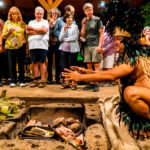
Less than 4 months ago, the Chilean-German lyric soprano, Ilse Simpfendorfer-Hagemann, with a vast experience in formation of choirs and creator of the first permanent school of ancestral Mapuche music in Pucón, arrived on the Island invited by the Municipality of Isla de Pascua and the magazine “Moe Varua”to offer voice lessons with the goal of forming a choir in which adults and children can develop their skills academically. Throughout the history of the Island, many groups have been formed, due to the enormous innate artistic and musical abilities of the Islanders, to present the ancestral music and dance of their forefathers. Today, the young people are promoting their culture, fusing ancient songs, rhythms and instruments with modern influences. Both Catholic and Evangelical churches have their traditional choirs for Sunday services. Recently in 2013, the internationally-known concert pianist Mahani Teave began her School of Music so that the Island children would have the possibility of developing their talents in different arts and specialized musical instruments.
And, what about vocal techniques, the needed skills to be able to sing or even speak correctly and safely? Several people have stopped Ilse Simpfendorfer in the street … “Are you Ilse? … I want to learn to sing because I’m getting hoarse.” Ilse recognizes those symptoms: “It’s necessary to maintain the instrument that is our voice in good shape to avoid hoarseness and the formation of nodules until very late in life. Our voice box isn’t just in the throat, but actually uses open sinus spaces located behind the nose and the cheeks. In order to sing, just as to talk, it’s necessary to learn to relax the neck and shoulders, breathe well, let the voice resonate, articulate and vocalize. It’s very useful to understand how the voice really works and what happens at a muscular level when we sing.”
This cultural project will require both public and private support. Included in the agenda of the Municipal Department of Culture for this month will be the topic of vocal education for the further development of the Rapa Nui Choir for adults and another for children which will start with the school year in March. Rehearsals will be scheduled at the Centro Cultural Tongariki or in another location to be determined. Those who are interested in participating should contact: Francisco Haoa, manager of the Municipal Department of Culture; Helga Thieme, editor of the magazine “Moe Varua” at Tahai s/n, (helgathieme@entelchile.net); or Ilse Simpfendorfer at ilse.music.blogspot.com (ilse.simpfendorfer@gmail.com). The choir counts with the auspices of the Chilean-German Chamber and the Hamburg-Valparaiso Cultural Forum, which have shown interest in a future tour for the choir in Germany.










